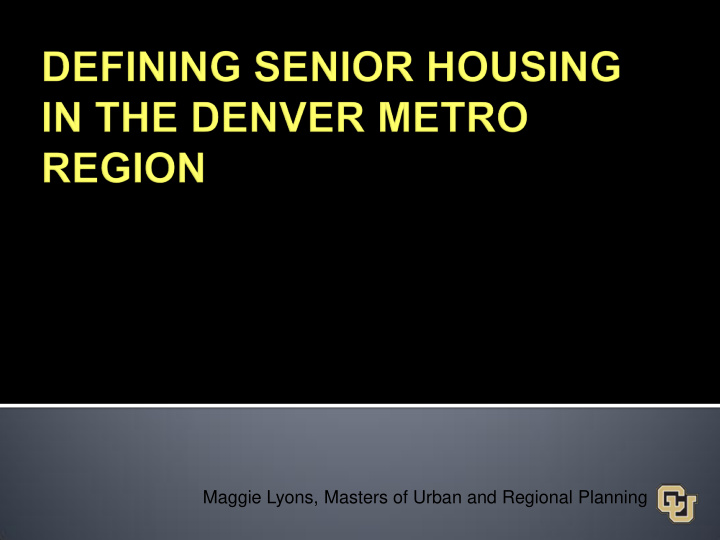



Maggie Lyons Maggie Lyons, Masters of Urban and Regional Planning
What is the current status, barriers, strengths and opportunities for senior housing options in the Denver Metro Region, particularly near transit ?
How can planning and policies can be effective in navigating the current and continuing issue of housing and mobility for the aging population?
Varying contexts for what age constitutes a “senior” Based on the ages at which one is eligible for various services or protections that organizations provide
Three main generations of older adults that constitute “senior” Wide range of seniors creates a variety of market segments AGE AGE 51 100+ LEADING SILENT GREATEST EDGE GENERATION GENERATION BOOMER
Age: 59
Age: 58
Age: 70
Age: 90
GROWTH 4 th fastest rate of growth in 65+ between 2000-2010 32% rate of growth overall between 2000-2010; individual counties, anywhere between 30 to over 100% growth Seniors were ~10% of population in Denver Metro counties in 2010, and estimated to be 14.3% by 2020 Projected 50-75% increase within senior population of current numbers by 2020: ~400,000 people 3 out of 5 of the fastest growing senior population counties are in the Denver Metro Region: Jefferson, Arapahoe and Douglas Counties
HEALTH CO Ranks 8 th in the U.S in senior health Three biggest health strengths: - Low obesity - High physical activity - Overall high health Three biggest health challenges: - Chronic drinking - Underweight seniors - Poor diabetes management 34% have disability, and projected that 69% will at some point
INCOME Median annual income in 2014 for women 65+ was $39,156 and for men 65+ was $50,648 Average annual income in the Denver Metro currently for women 65+ is $23,405 and for men 65+ is $29,855 Many older adults are currently on fixed incomes Social security benefits stagnant in 2014-2015 Approximate number of 65+ at or below poverty level is 55,000 Projected to increase to nearly 100,000 in 2030
Source: www.denverurbanism.com Seniors comprise largest percentage of homeowners 55,000 people 65+ living in single family units Primarily single family homes, ranch style common
DOWNSIZING PROPERTY TAXES / AGE IN PLACE HOME INSURANCE AGE IN HOME IN-MIGRATION TO URBAN AGE IN COMMUNITY CARE/SERVICE NEEDS
Do we have the product we need?
Average move-in age to independent living Average move-in age to assisted living or memory care type facility Percent of seniors that will move into service/care facilities in their lifetime, often represented by a year stay in a nursing home.
Gaps exist across entire spectrum of housing Major immediate housing product needs are for ages 65 to 82 Most critical needs are: - Senior affordable housing - Affordable with-service - For-sale attached units - Creative solutions for linked housing and services
Traditional model is not meeting changing needs and preferences, for an increasing population 1. COMMUNITY-LED DEVELOPMENT 2. MIXED-USE SENIOR AFFORDABLE
COMMUNITY-LED DEVELOPMENT Started as idea for condominium development Community-led effort for affordable senior housing in a municipality where there currently is none Senior co-housing group and team of 3 developers working out partnership with local senior center New senior center (modern, expand from 8,000 SF to 11,000 SF on ground floor) incorporate attached senior affordable rental housing (3 stories above senior center, appx. 40 units) Majority of apt. restricted to seniors with incomes < $40,000/yr. Development team is presenting December 10, 2015 for approval If approved, will be a benchmark development in the U.S.
MIXED-USE SENIOR AFFORDABLE DHA’s St. Anthony’s senior housing development, part of the mixed-income, mixed-use multi- phase development on the former St. Anthony’s site 100% of the 122 units are getting project-based vouchers for tenants at 30% AMI or below. 28,700 SF community health clinic in ground floor of the affordable senior housing project, operated by a local nonprofit healthcare provider. Beneficial in saving transportation and service costs for both the seniors, as well as the healthcare and general communities Clinic anticipated to serve 12,000 patients annually from the surrounding community Creative partnership options between DHA and the local healthcare provider - Discounts on rent for the clinic discounted medical costs for tenants Scheduled to break ground in Q4 of 2016
There is no silver bullet solution, but we need variety of creative solutions.
Thank you! Questions? Maggie Lyons Masters of Urban and Regional Planning University of Colorado Denver E: maggs099@gmail.com C: 719-650-6323
Recommend
More recommend